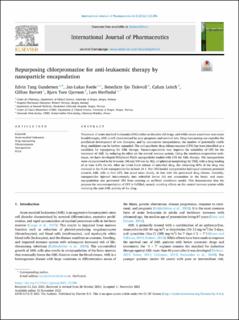| dc.contributor.author | Gundersen, Edvin Tang | |
| dc.contributor.author | Førde, Jan-Lukas | |
| dc.contributor.author | Tislevoll, Benedicte Sjo | |
| dc.contributor.author | Leitch, Calum | |
| dc.contributor.author | Barratt, Gillian | |
| dc.contributor.author | Gjertsen, Bjørn Tore | |
| dc.contributor.author | Herfindal, Lars | |
| dc.date.accessioned | 2022-02-02T10:34:35Z | |
| dc.date.available | 2022-02-02T10:34:35Z | |
| dc.date.created | 2021-12-30T19:15:55Z | |
| dc.date.issued | 2022 | |
| dc.identifier.issn | 0378-5173 | |
| dc.identifier.uri | https://hdl.handle.net/11250/2976625 | |
| dc.description.abstract | Treatment of acute myeloid leukaemia (AML) relies on decades-old drugs, and while recent years have seen some breakthroughs, AML is still characterised by poor prognosis and survival rate. Drug repurposing can expedite the preclinical development of new therapies, and by nanocarrier encapsulation, the number of potentially viable drug candidates can be further expanded. The anti-psychotic drug chlorpromazine (CPZ) has been identified as a candidate for repurposing for AML therapy. Nanoencapsulation may improve the suitability of CPZ for the treatment of AML by reducing its effect on the central nervous system. Using the emulsion-evaporation technique, we have developed PEGylated PLGA nanoparticles loaded with CPZ for AML therapy. The nanoparticles were characterised to be between 150 and 300 nm by DLS, of spherical morphology by TEM, with a drug loading of at least 6.0% (w/w). After an initial burst release of adsorbed drug, the remaining 80% of the drug was retained in the PLGA nanoparticles for at least 24 h. The CPZ-loaded nanoparticles had equal cytotoxic potential towards AML cells to free CPZ, but acted more slowly, in line with the protracted drug release. Crucially, nanoparticles injected intravenously into zebrafish larvae did not accumulate in the brain, and nanoencapsulation also prevented CPZ from crossing an artificial membrane model. This demonstrates that the purpose for nanoencapsulation of CPZ is fulfilled, namely avoiding effects on the central nervous system while retaining the anti-AML activity of the drug. | en_US |
| dc.language.iso | eng | en_US |
| dc.publisher | Elsevier | en_US |
| dc.rights | Navngivelse 4.0 Internasjonal | * |
| dc.rights.uri | http://creativecommons.org/licenses/by/4.0/deed.no | * |
| dc.title | Repurposing chlorpromazine for anti-leukaemic therapy by nanoparticle encapsulation | en_US |
| dc.type | Journal article | en_US |
| dc.type | Peer reviewed | en_US |
| dc.description.version | publishedVersion | en_US |
| dc.rights.holder | Copyright 2021 The Authors | en_US |
| dc.source.articlenumber | 121296 | en_US |
| cristin.ispublished | true | |
| cristin.fulltext | original | |
| cristin.qualitycode | 2 | |
| dc.identifier.doi | 10.1016/j.ijpharm.2021.121296 | |
| dc.identifier.cristin | 1973061 | |
| dc.source.journal | International Journal of Pharmaceutics | en_US |
| dc.identifier.citation | International Journal of Pharmaceutics. 2022, 612, 121296. | en_US |
| dc.source.volume | 612 | en_US |

